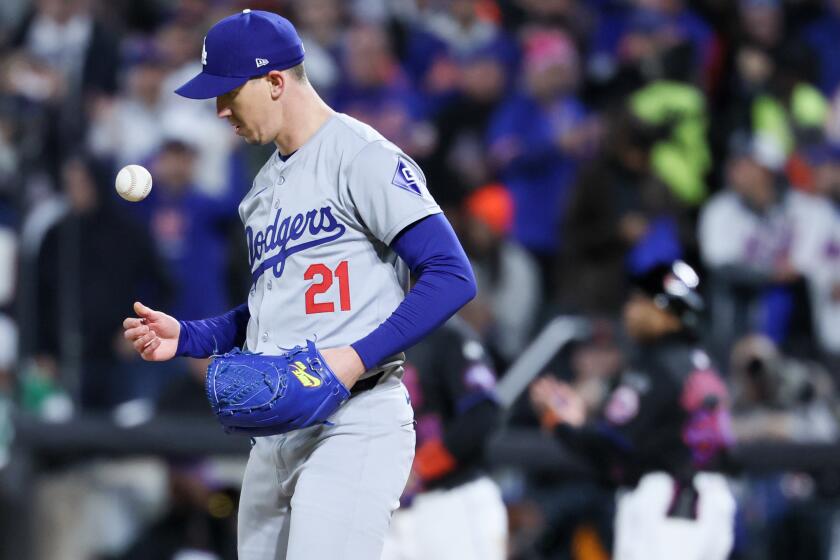Dodgers giving Korean rookie Hyeseong Kim every chance to succeed

- Share via
PHOENIX — At the end of infield workouts most days during spring training, the Dodgers do a live-fungo drill in which every player has to field a ball cleanly and make an accurate throw to first base. If one fielder bobbles a grounder or makes an errant throw, they all have to start over again.
Whether it’s rookie hazing, mettle testing, or both, the Dodgers usually force new infielder Hyeseong Kim, the 26-year-old from South Korea, to go last, with other infielders chanting, “Let’s go Dodgers!” as the grounder is hit in an attempt to rattle Kim while shortstop Mookie Betts is encouraging fans to join in on the chant one day.
“We kind of make him work a little bit and get him used to feeling the pressure in those situations, trying to simulate two outs in the ninth inning, and he’s gotta make a big play,” Dodgers utility man Tommy Edman said. “I don’t think he’s missed one yet.”
Roki Sasaki, the highly coveted 23-year-old right-hander who is making the jump from Japan to the major leagues, is generating the most curiosity and intrigue in Dodgers camp, but Kim, the slick-fielding utility man who won four Gold Glove Awards in the Korean Baseball Organization, is a close second.
Will the left-handed-hitting Kim, a lean 5-foot-10, 176-pounder who was a .304 hitter in six-plus KBO seasons, be able to handle the higher velocity and nastier breaking balls and off-speed pitches that he’ll see in the U.S.?
Will he hit for more power in the major leagues than he did in Korea, where he produced just 37 homers and 150 doubles in 953 games, or continue to be more of a slap hitter who relies on contact and speed?
While he still has symptoms of a possible concussion, including a headache and difficulty sleeping, he’s putting the moment behind him.
Will Kim be able to play shortstop, third base and the outfield well enough to develop into the utility player the Dodgers envision? Or will his potential defensive shortcomings at those spots relegate him to second base?
It will take several weeks, perhaps months, for those questions to be answered, but after two weeks of camp, veteran shortstop Miguel Rojas is sure of at least one thing:
“He can be a Gold Glove Award winner, a Platinum Glove winner, at second base — I can tell you that right now,” Rojas said. “The guy really makes the plays. He seems really athletic. He turns double plays really well. He’s not flashy at all. He just catches the ball and makes the play. I’m excited. He has the opportunity to do something special.”
Kim’s best position is clearly second base, as evidenced by the hardware he has earned and the KBO highlight reels he has produced, but the Dodgers plan to fully test his versatility this spring before scrapping the utility man idea.
Kim played shortstop in Saturday’s exhibition game against Kansas City, booting a first-inning grounder for an error before fielding three grounders cleanly and throwing to first base in the third and fourth innings.
Manager Dave Roberts said Kim will also get starts in center field, a position he has never played in Korea, the corner outfield spots and third base.
“I think that we’ve got a lot of different options,” Roberts said of Kim’s defensive ability. “We know that he can play second. James [Outman] and Andy [Pages] are competing in center field, and Tommy [Edman] can play there, but there’s not a lot of downside to having another left-handed option that can play center.
“I think the floor is, we know he can play second base, but we can kind of experiment and see what his comfort level is in other spots.”
Tony Gonsolin, pitching in a competitive big-league environment for the first time in 18 months, gave up a leadoff single before getting a flyout and two strikeouts.
How much Kim plays could ultimately be determined by how well he hits, and how well he hits will be determined by how well he adjusts to pitching in the major leagues, where the average fastball velocity of about 94 mph last season was considerably higher than the KBO average of 90 mph.
Kim, working with hitting coaches Robert Van Scoyoc and Aaron Bates, has already incorporated several mechanical changes to his swing, and Edman, who played with Kim on South Korea’s 2023 World Baseball Classic team, said Kim looks stronger and more physical now than he did two years ago.
“I know the higher velocity is going to be a little bit of a transition for him, but I think his swing will adapt well, since it isn’t super long, like a lot of swing-and-miss guys have,” Edman said. “He’s a more contact-oriented guy, and I think that will allow him to adjust to the velo a little bit easier than someone else.”
Some of Kim’s adjustments will come well before he steps into the batter’s box — they’ll come in the video room and in meetings with coaches and members of the analytics staff.
“He’s in a league where everybody has really good stuff, and they’re gonna figure him out and try to attack his weaknesses,” Rojas said. “So how quickly he can adjust back to the league is going to be important.”
The Dodgers took a bit of a gamble when they signed Kim to a three-year, $12.5-million deal with options for 2028 and 2029 that could boost the deal to $22 million. Only a handful of Korean position players, most notably outfielder Shin-Soo Choo and infielder Ha-Seong Kim, have thrived in the big leagues.
But the Dodgers believe Kim has the aptitude, athletic ability and work ethic to be a productive big-league player.
“You see the swing path, the makeup, the work ethic and how coachable he is, and that was through the roof,” Dodgers general manager Brandon Gomes said. “So then you’re betting that there’s bat-to-ball there … you bet on the athlete and the ability to make adjustments. There’s a lot of really good pieces in place.
“But there’s really no way to simulate that other than to see major league pitching and high-end pitching that is different from what he’s seen in the past. So we’ll continue to evaluate and bet on him making the adjustments down the road.”
Kim went hitless in four at-bats with one strikeout and one walk in his first two exhibition games before hitting a single and drawing a walk Sunday. While it’s far too soon to draw any conclusions about his early play, he is eager to collect a few hits.
“Everyone has been welcoming — the transition period hasn’t been a problem because everyone has been great to me so far,” Kim said through an interpreter. “But now it’s time to show a bit more results and show that I’m ready to play in Dodger Stadium.”
More to Read
Are you a true-blue fan?
Get our Dodgers Dugout newsletter for insights, news and much more.
You may occasionally receive promotional content from the Los Angeles Times.











